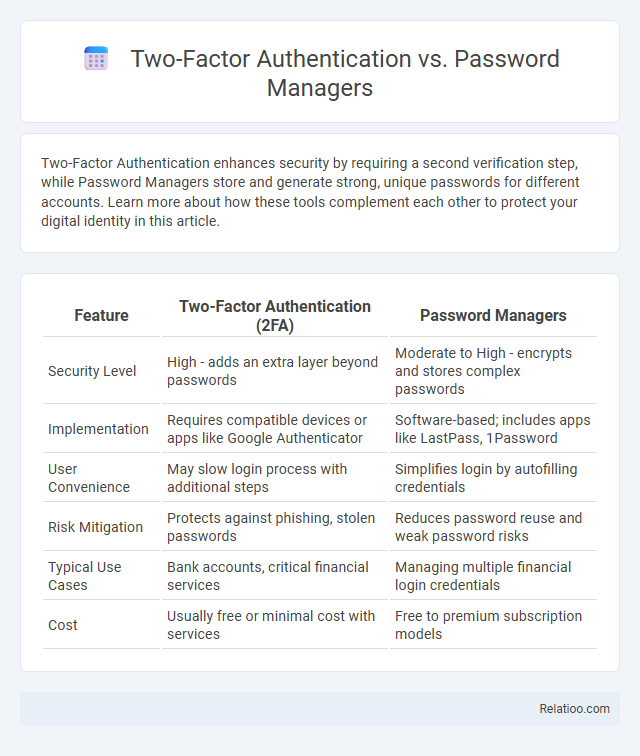Two-Factor Authentication enhances security by requiring a second verification step, while Password Managers store and generate strong, unique passwords for different accounts. Learn more about how these tools complement each other to protect your digital identity in this article.
Table of Comparison
| Feature | Two-Factor Authentication (2FA) | Password Managers |
|---|---|---|
| Security Level | High - adds an extra layer beyond passwords | Moderate to High - encrypts and stores complex passwords |
| Implementation | Requires compatible devices or apps like Google Authenticator | Software-based; includes apps like LastPass, 1Password |
| User Convenience | May slow login process with additional steps | Simplifies login by autofilling credentials |
| Risk Mitigation | Protects against phishing, stolen passwords | Reduces password reuse and weak password risks |
| Typical Use Cases | Bank accounts, critical financial services | Managing multiple financial login credentials |
| Cost | Usually free or minimal cost with services | Free to premium subscription models |
Introduction to Digital Security
Two-factor authentication enhances digital security by requiring users to provide two forms of verification, typically a password and a secondary code, reducing the risk of unauthorized access. Password managers securely store and generate complex passwords, minimizing the likelihood of password reuse and weak credentials that hackers exploit. Identity theft prevention relies on both tools to protect sensitive personal information from cybercriminals aiming to steal identities through phishing, data breaches, or social engineering attacks.
What is Two-Factor Authentication (2FA)?
Two-Factor Authentication (2FA) enhances your online security by requiring two forms of verification before granting access, typically combining something you know (password) with something you have (a smartphone app or hardware token). This added layer significantly reduces the risk of identity theft, as even if your password is compromised, unauthorized users cannot bypass the second authentication step. Using 2FA alongside password managers strengthens your defense against cyber threats by ensuring both strong, unique passwords and an extra verification barrier.
How Password Managers Work
Password managers securely store and encrypt your login credentials, generating strong, unique passwords for each account to prevent unauthorized access. Unlike two-factor authentication, which adds a layer of verification, password managers streamline your online security by autofilling passwords and reducing the risk of weak or reused passwords that contribute to identity theft. Using a trusted password manager enhances your digital safety by minimizing vulnerabilities associated with password management.
Key Differences: 2FA vs Password Managers
Two-Factor Authentication (2FA) enhances security by requiring two forms of verification, such as a password plus a unique code from an app or SMS, significantly reducing the risk of unauthorized access compared to using passwords alone. Password Managers store and encrypt your complex passwords, enabling you to use strong, unique credentials for each account without the need to remember them all, but they do not provide additional verification steps like 2FA. You should use 2FA to add an extra layer of protection beyond what password managers offer, especially to safeguard sensitive accounts from identity theft.
Security Benefits of Two-Factor Authentication
Two-Factor Authentication (2FA) significantly enhances cybersecurity by requiring users to provide two forms of verification, reducing the risk of unauthorized access compared to sole reliance on passwords stored in password managers. Unlike password managers that primarily safeguard credential storage, 2FA actively prevents identity theft by adding an extra security layer, such as a biometric factor or a one-time code. This dual requirement drastically lowers the chances of account compromise from phishing, hacking, or credential stuffing attacks.
Advantages of Using Password Managers
Password managers enhance security by generating and storing complex, unique passwords for each online account, significantly reducing the risk of identity theft caused by password reuse or weak credentials. Unlike two-factor authentication, which requires an additional verification step, password managers streamline login processes while maintaining strong protection against unauthorized access. They offer encrypted vaults accessible only by a master password, facilitating secure management of numerous accounts and minimizing password fatigue.
Potential Weaknesses and Risks
Two-Factor Authentication (2FA) can be vulnerable to SIM swapping and phishing attacks, compromising your account security despite an extra verification layer. Password managers, while simplifying credential management, pose risks if their master password is weak or if the software suffers from vulnerabilities that hackers exploit. Identity theft remains a significant threat as attackers use stolen credentials and personal information to bypass both 2FA and password managers, emphasizing the need for vigilant security practices.
Ease of Use and User Experience
Two-Factor Authentication enhances security by requiring a second verification step, offering strong protection but sometimes complicating login processes and slightly reducing ease of use for users. Password Managers streamline your experience by securely storing and auto-filling complex passwords, improving convenience without sacrificing safety. In contrast, Identity Theft prevention relies heavily on both tools working seamlessly together to protect your personal data while maintaining a user-friendly experience.
Best Practices for Combining 2FA and Password Managers
Combining two-factor authentication (2FA) with password managers significantly enhances digital security by adding multiple layers of protection against identity theft. Best practices include using password managers to generate and store complex, unique passwords while enabling 2FA on all critical accounts to require a second form of verification, such as a biometric scan or an authentication app code. This dual approach effectively mitigates risks associated with password reuse and phishing attacks, creating a robust defense against unauthorized access.
Final Thoughts: Choosing the Right Security Solution
Choosing the right security solution depends on your specific needs and risk tolerance, as two-factor authentication (2FA) adds an essential second layer of defense beyond passwords, significantly reducing unauthorized access. Password managers offer a practical way to generate and store complex, unique passwords, strengthening your overall security posture by preventing password reuse and simplifying credential management. To protect your identity effectively, combining 2FA with a reputable password manager creates a robust barrier against identity theft, ensuring your personal and financial information remains secure.

Infographic: Two-Factor Authentication vs Password Managers
 relatioo.com
relatioo.com